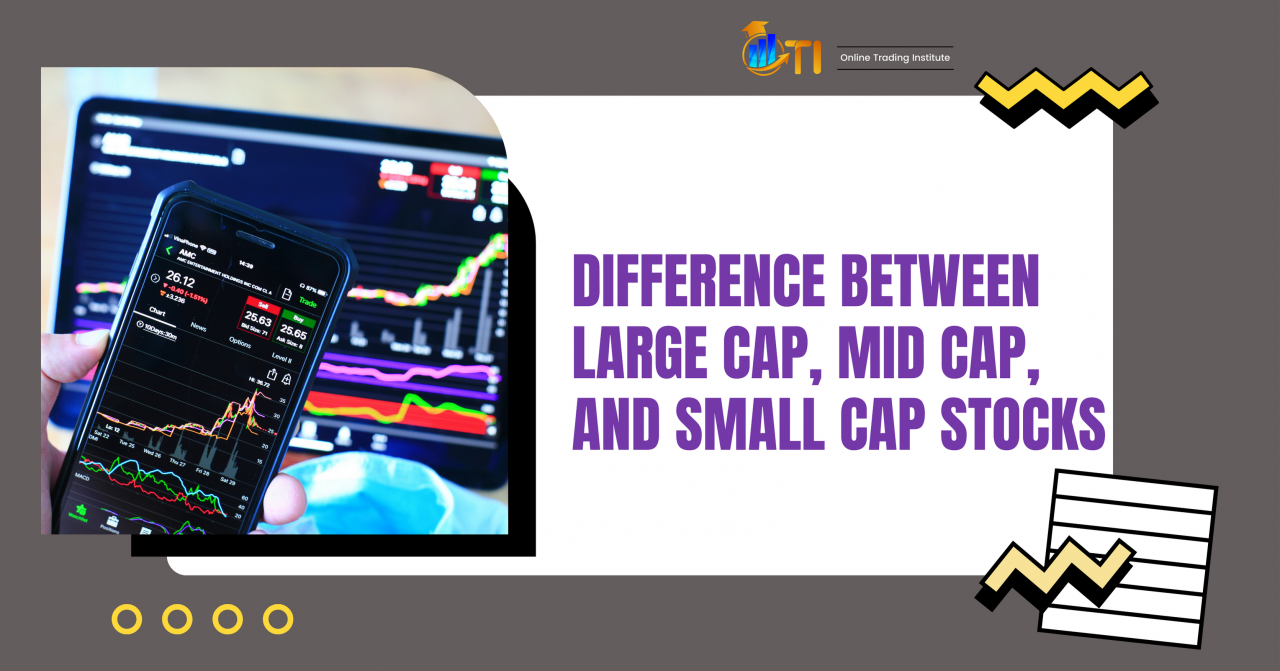Before you enter the world of stock market, it is important to know certain terms and concepts related to stock market.
So market capitalisation is one such fundamental trait which divides stocks into three separate categories known as large cap, mid cap, and small cap stocks.
In this blog, we will cite the difference between these three categories of stocks and provide you with general information about market capitalisation.
What is Market Capitalisation?
Before we know what large cap, mid cap, and small cap stocks are, let’s first know what market capitalisation is.
Market capitalisation, often known as market cap, is the total value of companies outstanding shares/stocks.
It is obtained by multiplying the market value of the outstanding shares by the current stock price.
Market capitalisation is a major indicator of companies size and is a vital factor for the investors looking to diversify their portfolios.
Example: Suppose, XYZ Company has 30,000 outstanding shares, and the current value of the stocks is ₹20, then the market capitalisation of the company would be as follows:
Market Cap: Outstanding Shares x Current Stock price
= 30,000 x ₹20
= 6,00,000
Therefore, the market capitalisation of XYZ company is ₹6,00,000.
Now. Let’s learn about the large cap, mid cap, and small cap stocks and the difference between them.

Large Cap Companies
Large Cap stocks represent the companies that have large market capitalisation. They are typically well-established, have a track record of stability and success, and are often regarded as industry leaders.
As per the investors knowledge large cap stocks are more stable and less risky.
Features of large cap companies:
- Stability and Consistency: Large cap companies have a history of steady earnings and stable performance. They have less rs\isk compared to mid cap and small cap companies.
- Global Presence: Many large cap companies are multinational with a global presence. These businesses expand beyond domestic markets, making them less susceptible to regional economic instability.
- Dividend Payments: Large cap businesses frequently give out dividends to their shareholders on a regular basis. They can be appealing to investors looking for a consistent income source as well as the possibility of capital expansion.
- Blue-Chip Status: Some large stock companies are classified as ‘blue-chip’, which means high-quality, financially sound companies with a proven record of consistent performance.
Some large cap companies
- Apple Inc (AAPL)
- Microsoft
- Johnson & Johnson
Mid Cap Companies
In regard to market capitalization, mid cap companies fall between large cap and small cap stocks. Companies in this group are typically in an expansion and growth phase, which makes them potentially more volatile than large size stocks but less risky than small cap stocks.
Features of Mid Cap Companies:
- Growth Potential: Mid-cap companies often find themselves in an expansion and growth phase. Investors are drawn to them because of their potential to grow in size and market share.
- Market Niche: Many mid cap companies operate in specialised niches, allowing them to capitalise on certain market trends or developing industries.
- Financial Flexibility: Mid cap companies have greater room for innovation and flexibility compared to large and small cap companies. They can quickly adjust to shifting market conditions and seek for new chances.
- Moderate Risk: Mid-cap stocks are said to have a moderate risk-reward profile. While they may be more volatile than large caps, they also have better growth potential than larger companies.
Some mid cap companies:
- LIC Housing Finance
- Bata Shoes
- Tata Communications
Small Cap Companies
Companies with a limited market capitalization are portrayed as small cap stocks. These firms are in the early stages of development, and while they might provide substantial growth potential, they also come with higher risk and volatility.
Features of Small cap companies:
- High Growth Potential: Small cap companies are believed to have the most potential for growth among all three categories. They might have new goods or services and the potential to expand their market share.
- Market Volatility: Small-cap stocks are more vulnerable to market swings and economic downturns. Because of their small size and limited resources, they are more susceptible to fluctuations in investor mindset.
- Limited Resources: Small cap companies may have fewer financial resources than their larger competitors. This can have an impact on their ability to survive economic downturns or market changes.
- Potential for Mergers and Acquisitions: Small cap companies may be targets for mergers and acquisitions by larger corporations wanting to extend their market position due to their smaller size.
Some small cap companies:
- Bajaj Consumer Care
- APL Apollo
- Alok Industries
Difference Between Large Cap, Mid Cap and Small Cap Stocks
| Criteria | Large Cap | Mid Cap | Small Cap |
| Market Capitalisation | Rs 20,000 crore or more | 5,000 crore to 20,000 crore rupees | Less than Rs 5,000 crore |
| Risk and Volatility | Lower volatility, lower risk | Moderate volatility, moderate risk | Higher volatility, higher risk |
| Growth Potential | Moderate growth potential | Higher growth potential | Potential for rapid and significant growth |
| Liquidity | High liquidity | Moderate liquidity | Low liquidity |
| Investor Profile | Conservative investors looking for stability | Moderately risk tolerant investors with long term investment horizon | Investors looking for rapid growth |
Factors to Consider for Investors
Understanding the differences between large cap, mid cap, and small cap stocks can be essential for making informed decisions while building an investment portfolio. Here are some things to think about as an investor:
Risk Tolerance
Consider your risk tolerance and investing goals. Large cap stocks are less risky in general, making them suitable for cautious investors, whereas small cap stocks may appeal to those wanting higher returns despite increased volatility.
Diversification
A well-diversified portfolio often comprises a mix of large, mid, and small cap stocks. Diversification can help reduce risk by splitting investments across multiple market areas.
Investment Horizon
A key factor is the period of time you want to hold onto your investments. To withstand volatility and reap possible returns, small size companies can need a longer investing horizon.
Market Conditions
Consider the current market conditions as well as the economic forecasts. Various market conditions may favour large caps during periods of stability and small caps during periods of economic growth.
Conclusions
Now that you are familiar with market capitalisation and its three categories: large cap, mid cap, and small cap, it will help you in making sound decisions.
Keep in mind the characteristics of all three markets caps and make safe and secure financial investments.
Get access to market news, updates and trends; follow our telegram channel @onlinetradinginstitute
| Disclaimer: The sole purpose of our financial articles is to provide you with educational and informative content. The content in these articles does not intend any investment, financial, legal, tax, or any other advice. It should not be used as a substitute for professional advice or assistance. |
